Vedic
Society
Temple
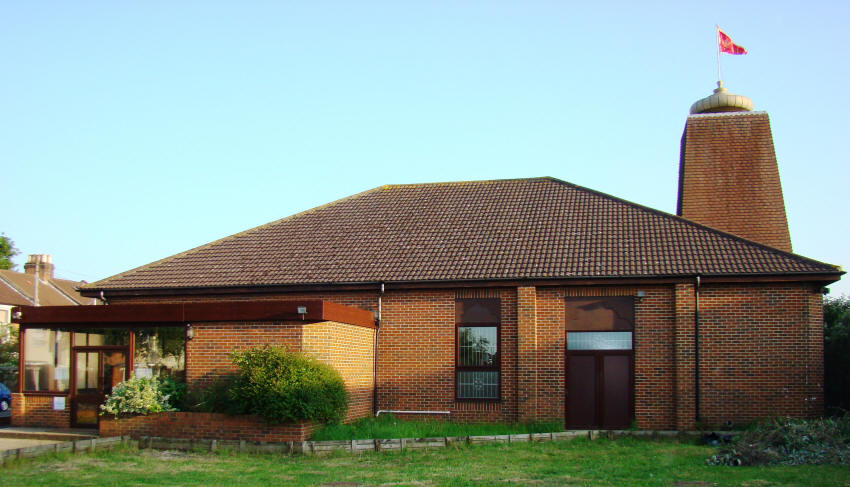
Vedic Society Hindu Temple
How to
get there
Temple Opening Hours
Monday - Saturday
Mornings:
9am - 12noon (Aarti at 10am)
Evenings: 5pm - 7pm (Aarti at 6:30pm)
Sunday
Mornings:
9:30am - 1:30pm (Aarti at 12noon)
Evenings: 5pm - 7pm (Aarti at 6:30pm)
Panoramic view
of the Temple
Panditji Shree Riteshkumar Bhatt
Click here for contact details
Schools, Colleges and Further Education Institutions
are most welcome to visit
Please complete the School Visit Application Form on
our 'Services 'page

The Shrines
| Shree Ganesha |
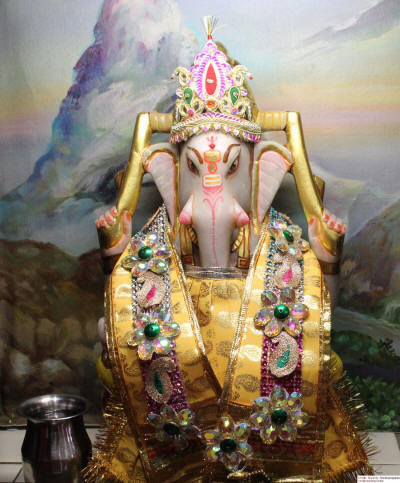 |
Shree Ganesha
As you enter, the first shrine you will come across on the far right
is that of Lord Ganesh. Lord Ganesh is one who removes all
obstacles in our path and is the Lord of Wisdom. Hindus pray to Lord
Ganesh at the start of any puja. Ganesh is also Shiva and Parvatiís
son. |
| Shiva Lingam |
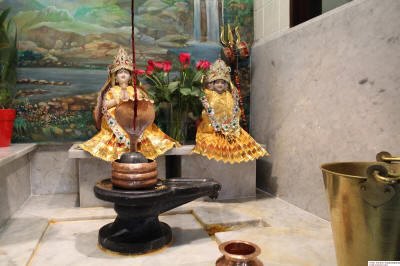 |
Lord Shiva is the oldest
Guru/teacher of the World and is the destroyer of evil in the Hindu
Trinity and Goddess Parvati is the goddess of Love and Devotion.
Lord Shiva is represented here in the form of the Shiva Linga (the
black stone in the ground). |
| Nandi (Bull) and Kurma (Tortoise) |
 |
The Tortoise and Nandi the
Bull
In front of the Shiva and Parvati shrine is a tortoise and a bull.
Nandi the bull is facing the Shivalinga. Nandi is Shivaís vehicle
and his foremost disciple, as well as gatekeeper to Shiva and
Parvatiís abode. Nandi is a symbol of 'Dharma' or righteous living.
He also symbolizes 'Will Power' and 'Strength' which help in one's
spiritual practice.A tortoise in the Shiva
Temple has a symbolic significance to inspire the devotees in their
spiritual practice. A tortoise has the ability to withdraw all its
limbs and head completely within its shell. This symbolically
inspires a spiritual aspirant to withdraw all his senses from the
material world. It is also a reminder for us to withdraw our senses
from the material world when we enter the mandir and focus our
attention on prayer and worship. |
|
Goddess Durga /
Amba Maa |
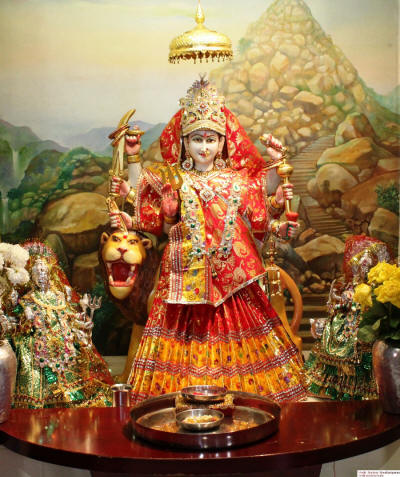 |
Goddess Durga /Amba Maa
Durga Maa (mother) is the Mother of the Universe and the Goddess of
Strength and Power. She is depicted as riding on a lion or a tiger.
A tiger symbolizes unlimited power. Durga riding a tiger indicates
that She possesses unlimited power and uses it to protect virtue and
destroy evil.
The lion is a symbol of uncontrolled animalistic
tendencies (such as anger, arrogance, selfishness, greed, jealousy,
desire to harm others etc.) and Her sitting on it reminds us to
control these qualities, so that we are not controlled by them.
|
| Shree Radha Krishna |
|
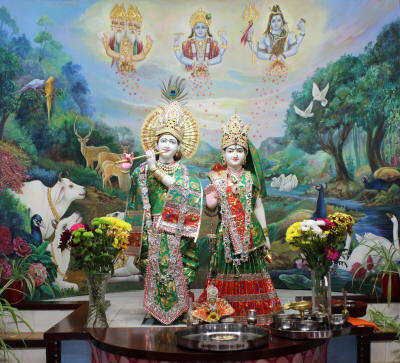 |
Radha Krishna
Lord Krishna is one of the more popular Gods in Hinduism and
represents Love. He is the 8th avatar of Lord Vishnu and came
down to earth to bring order in the world.
Radha is a divine female from the Hindu (Vedic) tradition. Like the
sun and sunshine, Krishna and Radha are one.
Radha embodies the totality of love for Krishna. Thus She is known
as the personification of Bhakti, or loving devotion to God.
Loving God is our natural state, now dormant. By Her pure example,
Radha is the beacon calling everyone to re-awaken full love for
Krishna.
Radha-Krishna are the female and male aspects of God. Known as the
Divine Couple, together they are the full manifestation of God.
Behind this shrine there is a painting of the Trinity: Brahma, the
creator; Vishnu, the preserver; and Shiva, the destroyer of evil.
They are showering down their blessings. |
| Shree Laxmi Narayan |
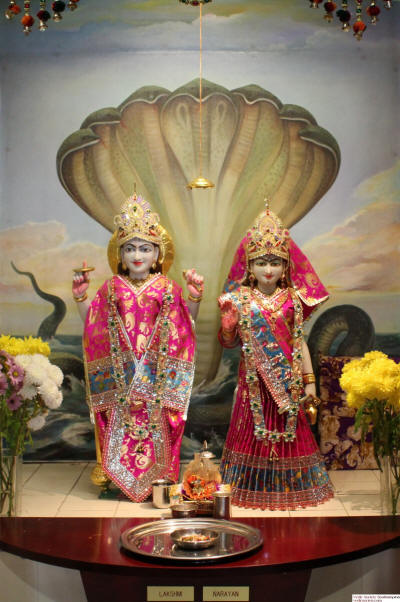 |
Lakshmi and Narayan
Lakshmi is the goddess of wealth and the consort of Lord Vishnu, or
Narayan, who represents the Power of Sustenance.
In order to sustain life, one must possess wealth. Wealth in this
context does not only mean money, it also includes the nobler values
of life, the power of the mind, intellect, moral and ethical
qualities etc. which constitute the spiritual wealth.
Lord Narayan is one of the trinity (Brahma, Vishnu, and Mahesh).
He is the One who manifests Himself in the world among mankind when
evil overrides goodness.
|
|
Sri Rama Darbar (Ramís Court) |
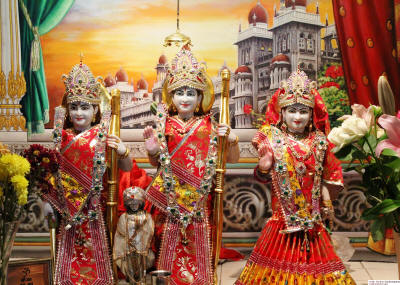 |
Sri Rama Darbar (Ramís
Court)
In Rama Court sits Sri Rama, with his wife Sita mata, his brother
Lakshman and his faithful devotee Sri Hanuman. Sita and Rama are the
ideal wife and husband in the Hindu tradition.
Rama is the seventh avatar/reincarnation of Vishnu. Rama is the
model of reason, right action and commendable virtues.
Sita is regarded as an avatar of the goddess Lakshmi, consort of
Vishnu.
When Vishnu took on human form as Rama, Lakshmi took on human form
as Sita.
Lakshmana was a half brother to Rama. He accompanied Rama and Sita
in their exile, and shared their struggles. |
| Shree Hanumanji |
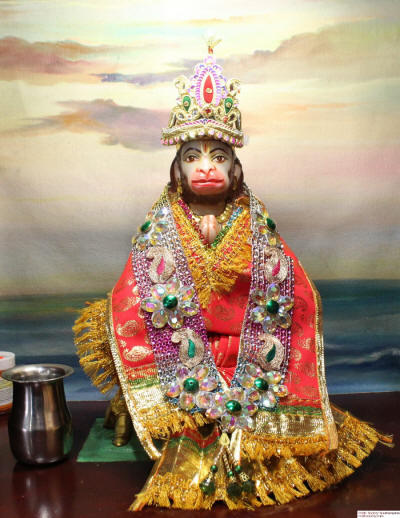 |
Hanuman
Hanumanji, whose image is in the form of a monkey, is particularly
associated with the Ramayana, the story of Rama and Sita. As a model
for human devotion to God, he is often depicted with hands brought
reverently together. He is a symbol of strength and loyalty
and represents the concept that animals are also a creation of God.
Hanuman is also regarded as a God in his own right and as the son of
the wind god he is able to fly and change shape at will. He is one
of the few Gods without a consort and leads a celibate life in
service to Lord Rama.
|
'The essence of all religions is one. Only their
approaches are different.'
Mahatma Gandhi 1937
Page last updated
22 August 2023

|










